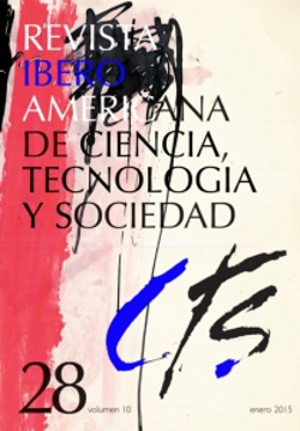What happened after Kuhn?
The relevance of philosophy of science for studies of scientific culture
DOI:
https://doi.org/10.52712/issn.1850-0013-571Keywords:
philosophy of science, social studies of science, Ibero-America, scientific culture, social dimensionAbstract
The philosophy of science and, particularly, the social studies of science and technology include several disciplines and fields of research, such as studies on public perception of science. In recent years, the study of scientific culture has become a field of great interest and relevance to the philosophy of science. This is especially visible in the Ibero- American region: its late arrival to this field has provided a revisionist research of many of the problems surrounding scientific culture and its measurement. The aim of this paper is to show how the philosophy of science can contribute to studies of public perception of science, particularly to the discussion on scientific culture.
Downloads
References
ALBORNOZ, M.; VACCAREZZA, L.; LÓPEZ CEREZO, J. A.; FAZIO, M. y POLINO, C. (2003): Proyecto: indicadores iberoamericanos de percepción pública, cultura científica y participación ciudadana. Informe final, Buenos Aires, OEI/RICYT/CYTED.
AMBROGI, A. (1999): Filosofía de la ciencia: el giro naturalista, Palma, Universidad de las Islas Baleares.
BAUER, M.; ALUM, N. y MILLER, S. (2007): “What can we learn of 25 years of PUS survey research? Liberating and expanding the agenda”, Public Understanding of Science, nº 16, pp. 79-95.
BECK, U. (1986): La sociedad del riesgo: Hacia una nueva modernidad, Barcelona, Paidós, 1998.
BERNAL, J. D. (1967): Historia social de la ciencia, Barcelona, Península.
CÁMARA HURTADO, M. y LÓPEZ CEREZO, J. A. (2008): “Dimensiones políticas de la cultura científica, en J. A. López Cerezo y F. J. Gómez González (eds.), Apropiación social de la ciencia, Madrid, Biblioteca Nueva-OEI, pp. 63-89.
CÁMARA HURTADO, M. Y J. A. LÓPEZ CEREZO (2010): “Political dimensions of scientific culture: highlights from the Ibero-American Survey on the social perception of science and scientific culture”, Public Understanding of Science, nº 1, pp. 1-16.
ECHEVERRÍA, J. (2003): La revolución tecnocientífica, Madrid, Fondo de Cultura Económica.
EDGE, D. (1995): “Reinventing the wheel” en S. Jasanoff, G. E. Msrkle, J. C. Petersen y T. Pinch (eds.): Handbook of science and technology studies, Sage, pp. 3-23.
FUNTOWICZ, S. O. y RAVETZ, J. R. (1993): Ciencia posnormal. Ciencia con la gente, Barcelona, Icaria.
GARCÍA RODRÍGUEZ, M. (2012): “La dimensión social de la cultura científica. Un caso ejemplar: Justus von Liebig”, Revista Iberoamericana de Educación, nº 58, pp. 135-149.
GIBBONS, M.; LIMOGES, C.; NOWOTNY, H.; SCHWARTZMAN, S.; SCOTT, P. y TROW, M. (1994): La nueva producción del conocimiento, Barcelona, Ediciones Pomares-Corredor.
GIDDENS, A. (1990): The Consequences of Modernity, Cambridge, Polity Press.
GODIN, B. y GINGRAS, Y. (2000): “What is scientific and technological culture and how is it measured?”, Public Understanding of Science, nº 9, pp. 43-58.
IRWIN, A. (1995): Citizen Science: A study of People, Expertise and Sustainable Development, New York, Routledge.
JASANOFF, S. (1990): The Fifth Branch. Science Advisers as Policymakers, Cambridge, Harvard University Press.
LÉVY-LEBLOND, J. M. (2003): “Una cultura sin cultura. Reflexiones críticas sobre la cultura científica”, Revista Iberoamericana de Ciencia, Tecnología y Sociedad - CTS, vol 1, nº 1, pp. 139-151.
LÓPEZ CEREZO, J. A. y CÁMARA HURTADO, M. (2009): “La cultura científica en España”, El español, lengua para la ciencia y la tecnología: presente y perspectivas de futuro, Instituto Cervantes, pp. 17-40.
MERTON, R. (1973): The Sociology of Science, Chicago, University of Chicago Press.
POLINO, C. (2004): “The wise and the ignorant, or a dangerous distinction for Latin American”, Journal of Science Communication, vol. 3, nº 3.
POLINO, C.; LÓPEZ CEREZO, J. A.; FAZIO, M. E. y CASTELFRANCHI, Y. (2006): “Nuevas herramientas y direcciones hacia una mejor comprensión de la percepción social de la ciencia en los países del ámbito iberoamericano”, en RICYT (2006): El Estado de la Ciencia. Principales Indicadores de Ciencia y Tecnología Iberoamericanos / Interamericanos 2006, Buenos Aires, RICYT, pp. 51-60.
STURGIS, P. J. y ALLUM, N. C. (2004): “Science in Society: Re-evaluating the Deficit Model of Public Attitudes,” Public Understanding of Science, nº 13, pp. 55-74.
VACCAREZA, L.; POLINO, C. y FAZIO, M. (2003): “Medir la percepción pública de la ciencia en los países iberoamericanos. Aproximación a problemas conceptuales”, Revista Iberoamericana de Ciencia, Tecnología e Innovación, nº 5.
VOGT, C. y POLINO, C. (2003): Percepción Pública de la Ciencia. Resultados de la Encuesta en Argentina, Brasil, España y Uruguay, Campinas, Editora UNICAMP/Sao Paolo, FAPESP.
WEINBERG, A. M. (1972): “Science and Trans-Science”, Minerva, nº 10, pp. 209-222.
WOOLGAR, S. (1988): Ciencia: abriendo la caja negra, Barcelona, Anthropos, 1991.
WYNNE, B. (1995): “Public Understanding of Science”, en S. Jasanoff, G. E. Msrkle, J. C. Petersen y T. Pinch (eds.): Handbook of Science and Technology Studies, Sage, pp. 361-388.
ZIMAN, J. (1984): Introducción al estudio de las ciencias. Los aspectos filosóficos y sociales de la ciencia y la tecnología, Barcelona, Ariel.
ZIMAN, J. (1991): “Public Understanding of Science”, Science, Technology and Human Values, nº 16, pp. 99–105.
ZIMAN, J. (1998): ¿Qué es la ciencia?, Madrid, Cambridge University Press.
Downloads
Published
How to Cite
Issue
Section
License
Copyright (c) 2024 CC Attribution 4.0

This work is licensed under a Creative Commons Attribution 4.0 International License.
All CTS's issues and academic articles are under a CC-BY license.
Since 2007, CTS has provided open and free access to all its contents, including the complete archive of its quarterly edition and the different products presented in its electronic platform. This decision is based on the belief that offering free access to published materials helps to build a greater and better exchange of knowledge.
In turn, for the quarterly edition, CTS allows institutional and thematic repositories, as well as personal web pages, to self-archive articles in their post-print or editorial version, immediately after the publication of the final version of each issue and under the condition that a link to the original source will be incorporated into the self-archive.











